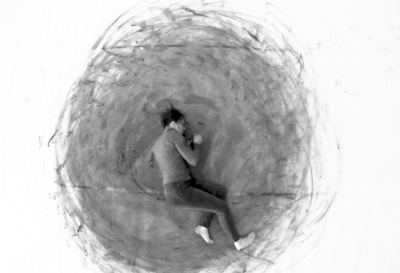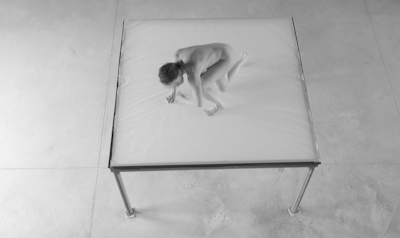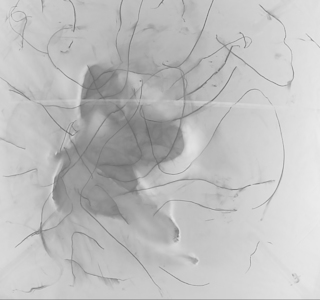Working low: activating the horizontal plane
Brown, Katrina  ORCID: https://orcid.org/0000-0001-9651-5233
(2020)
Working low: activating the horizontal plane.
In:
Body, Space, and Place in Collective and Collaborative Drawing: Drawing Conversations II (Hardback).
Drawing Conversations
.
Cambridge Scholars Publishing, Cambridge.
ISBN 9781527541962
ORCID: https://orcid.org/0000-0001-9651-5233
(2020)
Working low: activating the horizontal plane.
In:
Body, Space, and Place in Collective and Collaborative Drawing: Drawing Conversations II (Hardback).
Drawing Conversations
.
Cambridge Scholars Publishing, Cambridge.
ISBN 9781527541962
|
Text
DC2_Ch.3_Accepted version_K.Brown_Feb 2019.pdf - Accepted Version Restricted to Repository staff only Available under License Creative Commons Attribution Non-commercial. Download (2MB) |
|
![[thumbnail of Em[bed]ding circle_Book Chapter DC2_Fig 3.2]](https://repository.falmouth.ac.uk/3556/1.hassmallThumbnailVersion/Em%5Bbed%5Dding%20circle_K.Brown_video%20still.jpg)  Preview |
Image (Em[bed]ding circle_Book Chapter DC2_Fig 3.2)
Em[bed]ding circle_K.Brown_video still.jpg - Other Available under License Creative Commons Attribution Non-commercial. Download (798kB) | Preview |
![[thumbnail of TranslucentsurfaceQuietbody_Book Chapter DC2_Fig 3.4]](https://repository.falmouth.ac.uk/3556/2.hassmallThumbnailVersion/TranslucentsurfaceQuietbody_Book%20Chapter%20DC2_Fig%203.4.jpg)  Preview |
Image (TranslucentsurfaceQuietbody_Book Chapter DC2_Fig 3.4)
TranslucentsurfaceQuietbody_Book Chapter DC2_Fig 3.4.jpg - Other Available under License Creative Commons Attribution Non-commercial. Download (180kB) | Preview |
![[thumbnail of TranslucentsurfaceQuietbody_Book Chapter DC2_Fig 3.5]](https://repository.falmouth.ac.uk/3556/3.hassmallThumbnailVersion/TranslucentsurfaceQuietbody_Book%20Chapter%20DC2_Fig%203.5.jpg)  Preview |
Image (TranslucentsurfaceQuietbody_Book Chapter DC2_Fig 3.5)
TranslucentsurfaceQuietbody_Book Chapter DC2_Fig 3.5.jpg - Other Available under License Creative Commons Attribution Non-commercial. Download (396kB) | Preview |
Abstract / Summary
This chapter discusses how drawing, implemented as a choreographic activity in performance, activates the horizontal plane of the floor; bringing a performing body close to the receiving surface and in a ‘low’ orientation to the ground. In moving and drawing and in working-low, a performer might be considered to be quietly present among other objects, things, materials and bodies rather than operating in the ‘vertical plane of representation’ or presenting herself ‘in front’ of the viewers.
In three solo performance works: It’s a Draw/Live Feed (2003) by Trisha Brown, Loving Care (1993) by Janine Antoni and Panoramix (2004) by La Ribot, I consider how these three choreographers configure shifting relations between materials, surfaces and bodies (performing and spectating) in the gallery space– and the distinct way each performer orientates herself to the horizontal plane through their respective activities of ‘dancing-drawing’, ‘painting-cleaning’ and ‘scattering-toppling’.
Each of the works operates in the space of the gallery and invites audience to be mobile and orientate themselves within the work. Brown’s dancing-drawing on large sheets of paper is witnessed through a live feed projection on the gallery wall while her ‘drawing compositions’ are brought out one by one over the time of the performance to be suspended and viewed by the audience. Antoni works on hands and knees, swaying side to side while painting the floor with her hair, which over time manoeuvres the audience out of the gallery space. In Panoramix, spectators share the same soft cardboard-clad gallery floor with La Ribot as she increasingly discards her props and objects and they lie scattered over the floor.
These works are discussed in a reconsideration of horizontality through Leo Steinberg’s notion of the ‘flatbed picture plane’ (1972) which informs a choreographic view of the evidential remains of drawing, painting and scattering in relation to orientation and distribution: and how the practical operation of the ‘flatbed’ resonates within André Lepecki’s (2006) ‘toppling of the vertical plane of representation’ in performance and Svetlana Alpers’ (1984) ‘art of describing’. Together these generate an understanding of drawing outcomes that are produced from movement in relation to surface dimension and gravity; a way of considering the material remains in terms of distributed or organised information rather than in terms of image production; that information gathers and settles like dust on surfaces and the receiving plane of the flatbed operates as a site of evidence.
Examples from current performance and practical research are interwoven to highlight material-haptic-visual entanglements of moving and drawing in terms of gravitational force, sensation of weight and surface distributions of data. She’s only doing this: scores explore the score as task-based action, performance event and graphic residue: revealing how a durational process of moving, drawing, scoring generates its own time-space. In contrast, in Translucent surface/Quiet body a moving-drawing body is recorded from beneath the surface by a documenting camera, which inverts the relationship between moving body and receptor surface.
These works present different surfaces of skin, paper and floor and coinciding capacities of surface as support, receptor and screen: presenting a material encounter between moving body and static surface and a quiet orientation of body to surface.
| Item Type: | Book Section |
|---|---|
| ISBN: | 9781527541962 |
| Subjects: | Performance > Dance > Choreography Arts > Drawing |
| Courses by Department: | Academy of Music & Theatre Arts > Dance |
| Related URLs: | |
| Depositing User: | Katrina Brown |
| Date Deposited: | 01 Nov 2019 09:37 |
| Last Modified: | 11 Nov 2022 16:25 |
| URI: | https://repository.falmouth.ac.uk/id/eprint/3556 |
Actions
 |
View Item (login required) |

 Tools
Tools Tools
Tools